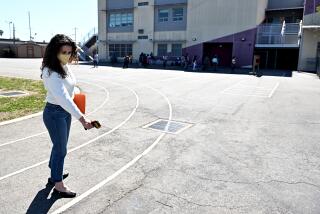Santa Monica-Malibu schools going mail-in route for parcel tax election
Neil Carrey has sometimes been critical of spending in the Santa Monica-Malibu school district. But now, he says, the district has done nothing wrong -- it’s just not getting enough money from the state.
“This is not like the boy who cried wolf,” he said. “This is real.”
As a result of anticipated budget shortfalls, the Santa Monica-Malibu Unified School District will ask voters -- by mail -- to support a parcel tax that could stave off teacher layoffs and maintain such classes as art and music. The five-year tax on residential and commercial property would be $198 per parcel, bringing the district’s per-parcel tax to $544, with a senior citizen exemption. The ballots will go out April 26 and are due May 25.
The district is using the mail-in election because the June 8 ballot will be crowded with other measures and could draw a relatively conservative group of voters, say strategists and others.
Special elections are more costly than putting a measure on an existing ballot. Doing them by mail, however, is cheaper than sending people to polls, officials said.
The Pasadena Unified School District will hold its first parcel tax election by mail in April. The ballots have to be received by the county by May 4. The $120-per-parcel tax would fund the district’s libraries and librarians, as well as math and arts programs. It would also maintain class sizes.
Carrey, who chaired the most recent parcel tax committee for the Santa Monica-Malibu district, said the effort was worth the expense of mailing out ballots.
“Sometimes it makes good economic sense to spend a little bit more money up front to give you a better chance of result,” Carrey said.
The Los Angeles Unified School District apparently disagrees. Its four-year, $100-per-parcel tax request will be tacked onto the June primary ballot.
“Given the amount of mail that has to go out to hit every property owner and every registered voter in the 710 square miles that we cover would just be cost prohibitive,” said Robert Alaniz, the district’s director of communications.
By any method, parcel taxes are a hard sell: They require a two-thirds majority to pass, and more affluent areas appear to be more willing to support them.
Still, from 2007 to 2009, the number of school districts attempting to pass parcel taxes in the state increased by 16%, according to data from EdSource, a nonprofit education policy organization.
“Parcel taxes can certainly help struggling districts, but not all districts have the capacity to pass them,” said Julian Leichty, a research assistant with the group.
Last year, Los Angeles County conducted five vote-by-mail parcel tax special elections. All the proposals passed, except the Rowland Unified School District’s.
“In a place like Rowland where there’s never been a parcel tax or a ballot measure to ask for that, it was completely new,” said Maria Ott, the superintendent of the 16,000-student district.
Fewer than 20% of voters were parents, according to the district.
Parcel taxes are an attractive option because they are less restrictive than bond measures: They can fund anything, including books, paper and teacher salaries, said Glenn Gritzner, a former strategist for L.A. Unified’s school construction bond campaigns. Also, the state can’t take the money away, said Rochelle Fanali, co-chairwoman of Santa Monica-Malibu’s Yes on Measure A campaign committee.
“Whether they [districts] think it’s politically difficult or not, they’re out of money and they’re out of ways to raise money,” Gritzner said. “They need to try everything.”
Even if a levy passes, the Santa Monica-Malibu district, among others, still will have to cut from its budget, Supt. Tim Cuneo said.
“If we don’t do anything right now, or don’t have the parcel tax, about two-thirds of the way into next year, we will be broke,” Cuneo said. “The story’s going to be much worse if it doesn’t pass.”
Shari Davis, who has three children in the Santa Monica district and works on the campaign, said proponents will have to hit the streets to help get the word out about the mail-in election, with visits to parent-teacher meetings and local businesses.
But she believes the voters are savvy because of past mail-in elections. About 19% of voters cast ballots by mail in the district, according to the county.
Davis said parcel taxes are vital to supporting education.
“It’s not like you can ask a child to hang in there,” she said.
nicole.santacruz
@latimes.com
More to Read
Sign up for Essential California
The most important California stories and recommendations in your inbox every morning.
You may occasionally receive promotional content from the Los Angeles Times.











